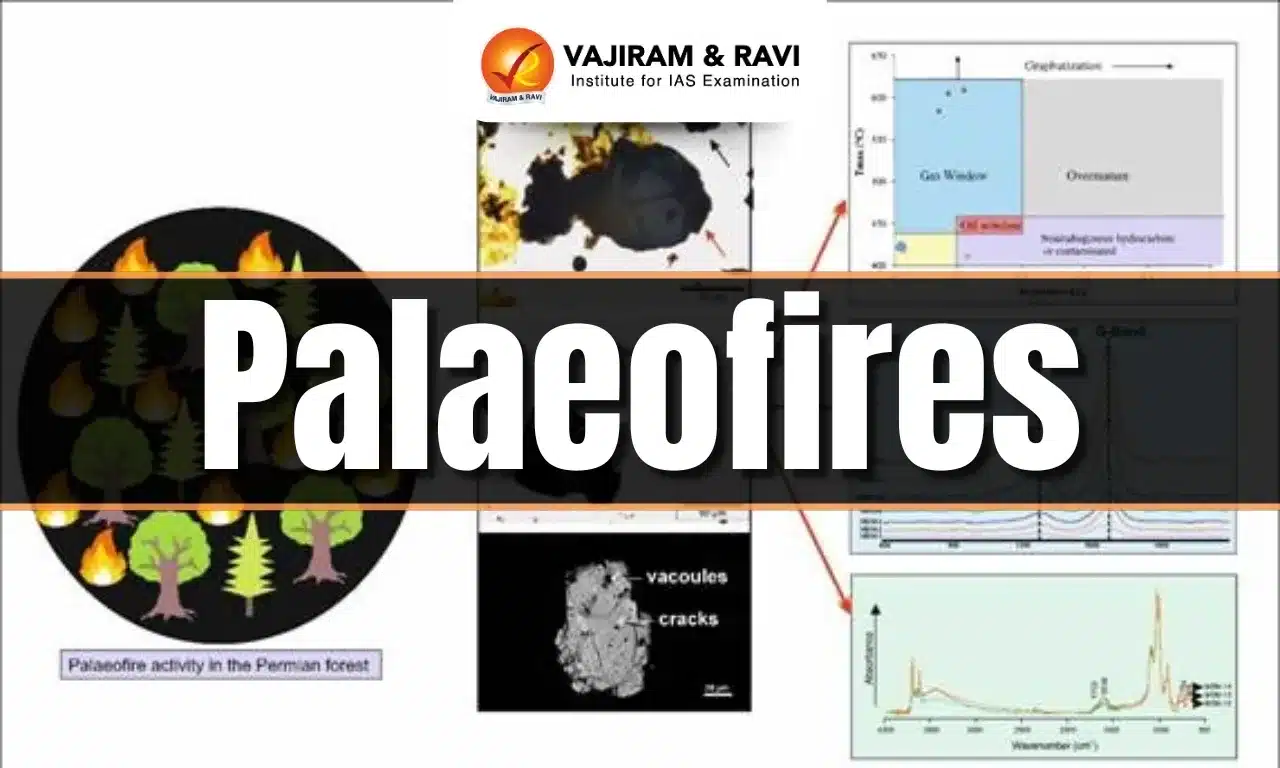Palaeofires Latest News
Recently, Scientists have traced evidence of palaeofires (ancient wildfires) from the Permian Period (~250 million years ago) in the Godavari Basin.
About Palaeofires and Key Findings
- Palaeofires refer to wildfire events preserved in geological records, which play a crucial role in understanding Earth’s past vegetation, climate evolution, and coal formation.
- The study spanned geological periods from the Late Silurian (443.8–419.2 million years ago) to the Quaternary (from 2.58 million years ago to present), highlighting how wildfires have historically shaped landscapes, vegetation patterns, and coal formation.
- The research combined advanced techniques like Palynofacies analysis, Raman Spectroscopy, Rock-Eval Pyrolysis, and FTIR Spectroscopy to examine microscopic organic matter and fossil charcoal in ancient sedimentary rocks.
- Palynofacies analysis revealed three main types of organic particles:
- Translucent Organic Matter (TrOM) – includes pollen and plant debris.
- Palaeofire Charcoal (PAL-CH) – direct evidence of vegetation burning.
- Oxidised Charcoal (OX-CH) – possibly reworked or transported post-burning.
- Key discovery: The team successfully distinguished between in situ (on-site) and ex situ (transported) charcoal, helping resolve a long-standing debate in geology regarding the origin of charcoal found in coal-bearing formations.
- Stratigraphic patterns (rock layering) revealed that:
- During regressive phases (sea-level drop), well-preserved, concentrated fire residues were found.
- During transgressive phases (sea-level rise), charcoal was more oxidised and dispersed, indicating environmental mixing and transport.
- High atmospheric oxygen levels in the Permian Period likely made the Earth more fire-prone, intensifying wildfire frequency and scale.
- The Raniganj Coalfield was one of the earliest Indian sites where macroscopic charcoal in coal seams suggested the presence of palaeofires in ancient peat-forming environments (palaeomires).
- These findings help understand how wildfires influence carbon cycling and long-term carbon sequestration—important for modern climate change mitigation strategies.
Palaeofires FAQs
Q1. What are palaeofires?
Ans. Palaeofires are ancient wildfires that occurred naturally in Earth’s geological past, identified through charcoal deposits, sediment records, and tree rings.
Q2. How are palaeofires studied?
Ans. Through palaeoecological and geological evidence, especially charcoal analysis in lake beds, peat, and ice cores.
Source: PIB
Beta feature
Last updated on January, 2026
→ Check out the latest UPSC Syllabus 2026 here.
→ Join Vajiram & Ravi’s Interview Guidance Programme for expert help to crack your final UPSC stage.
→ UPSC Mains Result 2025 is now out.
→ UPSC Notification 2026 is scheduled to be released on January 14, 2026.
→ UPSC Calendar 2026 has been released.
→ UPSC Prelims 2026 will be conducted on 24th May, 2026 & UPSC Mains 2026 will be conducted on 21st August 2026.
→ The UPSC Selection Process is of 3 stages-Prelims, Mains and Interview.
→ Prepare effectively with Vajiram & Ravi’s UPSC Prelims Test Series 2026 featuring full-length mock tests, detailed solutions, and performance analysis.
→ Enroll in Vajiram & Ravi’s UPSC Mains Test Series 2026 for structured answer writing practice, expert evaluation, and exam-oriented feedback.
→ Join Vajiram & Ravi’s Best UPSC Mentorship Program for personalized guidance, strategy planning, and one-to-one support from experienced mentors.
→ UPSC Result 2024 is released with latest UPSC Marksheet 2024. Check Now!
→ UPSC Toppers List 2024 is released now. Shakti Dubey is UPSC AIR 1 2024 Topper.
→ Also check Best UPSC Coaching in India
Tags: Palaeofires prelims pointers upsc prelims current affairs

















